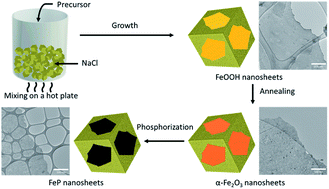Synthesis of two-dimensional hematite and iron phosphide for hydrogen evolution†
Abstract
Facile and scalable synthesis of two-dimensional (2D) non-layered materials is highly desirable for novel applications. Iron compounds including hematite (α-Fe2O3) and iron phosphide (FeP) are an important group of semiconductors but their 2D ultrathin morphology has been rarely reported. Here, we develop a water dissolvable template-based synthesis route to produce free-standing ultrathin iron compounds. Such a method also enables the tunability of morphology from mesoporous nanosheet to meso-macroporous hierarchical nanonet utilizing the aging process, while its corresponding surface active area is reduced simultaneously. Ultrathin hematite is relatively inert to electrochemical hydrogen evolution reaction (HER). However, FeP exhibits excellent catalytic performances with a relatively low overpotential of 117 mV and a Tafel slope of 56 mV dec−1, which is as a whole improved over those of reported free-standing binary transition-metal phosphide nanostructures. This work extends the possibility to produce high-quality 2D non-layered materials, which are expected to exhibit unique properties compared to their bulk counterparts.



 Please wait while we load your content...
Please wait while we load your content...